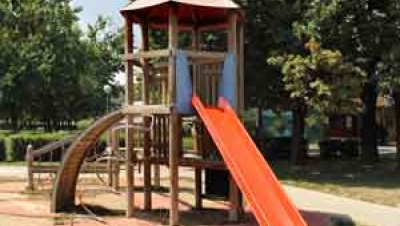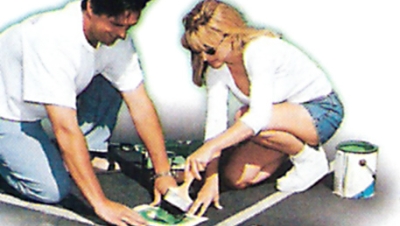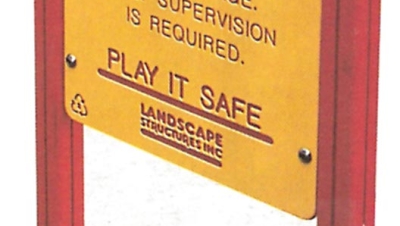The dangers of the burned playground
Few things are more frustrating to today’s playground professional than vandalism to the public spaces they are responsible for maintaining. It negatively affects staff, budgets, and even public safety. Commonly vandalism takes the form of graffiti, turf damage from cars and damage to site furnishings and amenities. However, an increasing trend in arson based vandalism on playgrounds throughout the U.S. and Canada raises concerns to a new level.
During a recent visit to Texas, I came face to face with the dramatic results of this type of vandalism and the impact it has on local communities and maintenance staff.
It had not rained for several months and the temperatures had been in the triple digits for many weeks. It was mid-July in central Texas and conditions were perfect for local vandals intent on burning the playground at their local park.
Their first attempt to burn the playground occurred over the weekend and did little except singe the wood-fiber ground cover. Not content with that level of damage, they returned one weekday afternoon and started a fire that consumed the playground and burned several nearby majestic oak trees. The dry grass around the play area also caught fire and, if not for the heroic efforts of the firefighters, would have spread the blaze to an adjacent forest preserve.
When I visited the play area the morning after the fire, I was shocked and saddened to see what had once been a beautiful playground nestled in the woods, reduced to blackened wood chips and grotesquely twisted metal. The ash-covered area was barely recognizable as a former playground. Children from the nearby neighborhood had gathered behind orange hazard fencing erected by the park department and told me in quiet voices what parts of the playground had been their favorites.
I was shocked to see maintenance workers trying to salvage play equipment components from the ashes without even the minimal protection of work gloves or dust masks.
Unfortunately, this playground, like nearly all those produced in North America, contained decks and a variety of other parts that had been thickly coated with Polyvinyl Chloride (PVC). It is an undisputed fact that highly toxic Dioxin and Polychlorinated Biphenyls (PCB’s) are formed when PVC is burned. The maintenance workers tasked with cleaning up the burned playground were not aware, until I informed them, that they were working without any protection in the midst of carcinogenic ash. While there are varying opinions as to the level of these substances that should trigger designation as a hazardous materials site, it is clear that the mere existence of these substances should elicit extreme care regarding both cleanup and removal of waste as well as the eventual re-use of the site by the public.
The Healthy Building Network (www.healthybuilding.net) has stated that, at a minimum, local health departments should be involved in assessing the risks posed by burned PVC in situations such as this, prior to any remediation. They should also be consulted to determine the proper method for disposing of the burned material and contaminated soil. In addition, maintenance departments should develop plans to ensure that staff wears protective clothing, gloves, and particle masks when cleaning affected areas.
For the past two years, I have traveled around North America speaking to park departments and school districts about this issue. I have yet to visit a town that does not have playground equipment with components coated with Polyvinyl Chloride. Why is this material so prevalent on today’s playgrounds? The reasons can be found in the material’s positive attributes:
It is moderately resilient and slip resistant
It insulates users from the extreme hot or cold of the bare metal
It is relatively durable and available in a variety of colors
It is cheap
There are many alternatives to the use of PVC in coating playground components – thermoplastic and reinforced recycled plastic are both readily available to manufacturers and do not pose the same hazards found in PVC. Public playgrounds in Europe have been built for years without PVC due to concerns over the impact to young children posed by the leaching of additives used to soften the coating.
Many arguments have been made against the use of Polyvinyl Chloride in general. Given the fact that I am not a scientist, I will leave concerns regarding the impact of PVC production, use and disposal to others. As a builder of playgrounds, my greatest concern stems from the issue that directly and clearly impacts those of us who provide public playgrounds for children. What happens when this material burns? What happens to the maintenance worker sent to clean up the mess? Can carcinogenic substances measured in parts per billion be properly cleaned up with a backhoe and a shovel? What will young children be exposed to when the playground is repaired or replaced?
Answers to these questions lie in the choices that we all make when selecting products for use in play spaces, both public and private. As a park district or school district employee reading this article, it is fair to ask: What can I do about this issue? It is simple. Exercise your power as a purchaser of commercial playground equipment to demand products that are free of Polyvinyl Chloride. Issue bid specifications that clearly state “No PVC.” As for your existing playgrounds: determine which ones contain Polyvinyl Chloride coated materials and develop a plan with your local firefighters, department of health, and maintenance staff to deal with the increasingly likely problem posed by this unfortunately common type of vandalism.












Add new comment